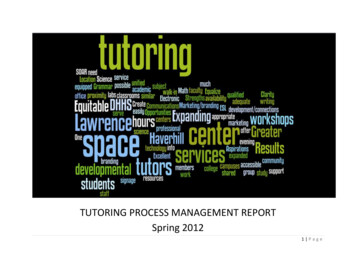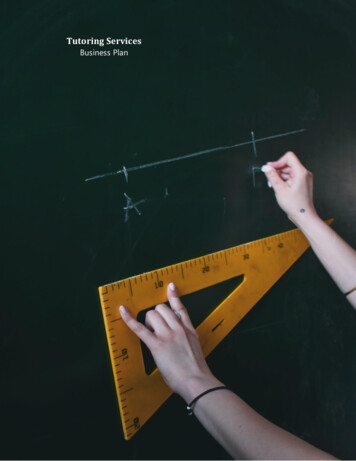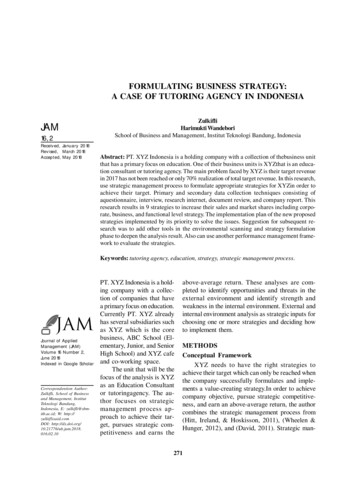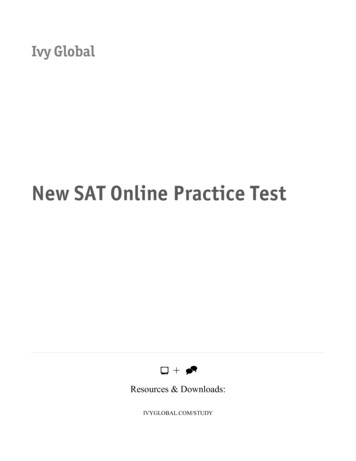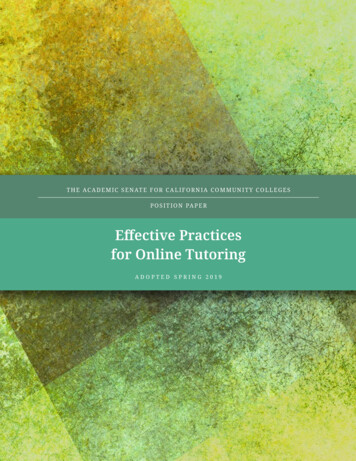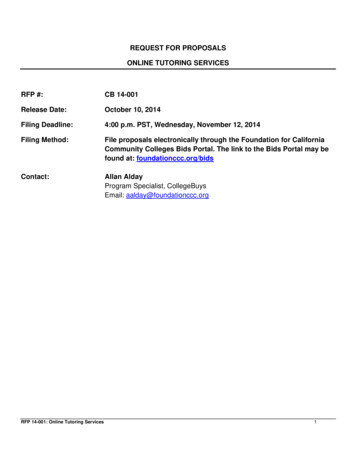
Transcription
Designing Intelligent Language Tutoring System for Learning Chinese CharactersbyJingyu LiuA thesis submitted to the graduate facultyin partial fulfillment of the requirements for the degree ofMASTER OF SCIENCECo-major: Industrial and Manufacturing Systems Engineering;Human Computer InteractionProgram of Study Committee:Stephen Gilbert, Major ProfessorMichael DorneichVolker HegelheimerIowa State UniversityAmes, Iowa2016Copyright Jingyu Liu, 2016. All rights reserved.
iiTABLE OF CONTENTSLIST OF FIGURES . IIILIST OF TABLES . VACKNOWLEDGMENTS . VIABSTRACT . VIICHAPTER 1 INTRODUCTION . 11.1 STATEMENT OF THE PROBLEM . 11.2 RESEARCH QUESTIONS . 21.3 BRIEF INTRODUCTION TO INTELLIGENT TUTORING SYSTEMS. 31.4 STUDY OVERVIEW . 51.5 THESIS ORGANIZATION. 6CHAPTER 2 LITERATURE REVIEW . 72.1 THE INTELLIGENT LANGUAGE TUTORING SYSTEM AND ITS DEVELOPMENT . 72.2 LEARNING CHINESE AS A SECOND LANGUAGE. 112.3 GAPS IN PREVIOUS WORK . 17CHAPTER 3 METHODS . 223.1 OVERVIEW . 223.2 STAGE 1: PREPARATION FOR CONTENT . 233.3 STAGE 2: DESIGN AND DEVELOPMENT . 323.4 STAGE 3: EVALUATION OF THE SYSTEM. 463.5 DATA ANALYSIS PLAN . 513.6 LIMITATIONS/ASSUMPTIONS . 52CHAPTER 4 RESULTS . 534.1 PARTICIPANTS . 534.2 LEARNING PERFORMANCE . 574.3 TIME SPENT. 674.4 NASA-TLX . 704.5 USABILITY QUESTIONS . 714.6 SURVEY QUESTIONS . 734.7 BEFORE AND AFTER COMPARISON . 78CHAPTER 5 DISCUSSION AND CONCLUSION . 845.1 PREDICTED OUTCOMES . 845.2 DISCUSSION OF FINDINGS. 855.3 CONCLUSIONS . 935.4 LIMITATIONS . 945.5 FUTURE WORK . 95REFERENCES . 98APPENDICES . 104
iiiLIST OF FIGURESFigure 1 Screenshot of Screen of TLTS (Johnson et al., 2004) . 9Figure 2 Screenshots of Screen of ELECT BiLAT (Lane et al., 2007) . 10Figure 3 Screenshot of screen of IN-TALE (Riedl & Stern, 2006) . 11Figure 4 The information processing of English vs. Chinese (Liu, 1978). 16Figure 5 Screenshot of interface of Kosek and Lison's work Kosek and Lison (2014) . 19Figure 6 Figure from of Ji's work (Hsiao et al., 2013). 20Figure 7 Screenshot of Lam's work (Lam et al., 2001). 21Figure 8 User-Centered Design Process per Dix et al. (2007) . 22Figure 9 Study flow chart . 23Figure 10 Conceptual framework - five planes (Garrett, 2003). 23Figure 11 Navigation (lesson selector menu) of the system . 32Figure 12 Progress indicator (left menu) of the system . 33Figure 13 Introduction page . 34Figure 14 Example of metaphor . 34Figure 15 Annotation panel . 35Figure 16 Etymology example . 35Figure 17 Concept of building blocks. 35Figure 18 Learning practice . 36Figure 19 Panda cartoon . 36Figure 20 Gamified path . 37Figure 21 Button samples . 37Figure 22 Color palette samples . 38Figure 23 Feedback samples . 39Figure 24 Paper prototype . 39Figure 25 Introduction pages (from page 1 to page 3). 41Figure 26 Tour pages (from page 1 to page 3). 43Figure 27 First page of “person” presentation . 44Figure 28 Following pages of “person” presentation . 45Figure 29 Participants' native languages . 55Figure 30 Number of languages learned . 55Figure 31 Attitudes toward Chinese . 56Figure 32 Boxplots of quiz scores between Group A and Group B . 58Figure 33 Means of higher and lower scores for undergrad, grad and faculty/staff (notsignificantly different) . 64Figure 34 Means of higher and lower scores for number of languages learned (differencesnot significant) . 66Figure 35 Time spent for learning, quiz and survey (error bars show standard error) . 68Figure 36 Time spent for each learning session (error bars show standard error) . 69Figure 37 Boxplots of NASA-TLX . 70Figure 38 Bar chart of usability questions (error bars show standard error) . 72Figure 39 Bar chart of overall satisfaction (error bars show standard error) . 74Figure 40 Comparison of usefulness by groups (error bars show standard error) . 75
ivFigure 41 Comparison of interface satisfaction by groups (error bars show standard error). 76Figure 42 Comparison of functionality by groups (error bars show standard error) . 77Figure 43 Changes of attitudes of Group A . 78Figure 44 Changes of attitudes of Group B . 78Figure 45 Changes before vs. after learning by groups (error bars show standard error) 80Figure 46 Decreases in difficulty for all participants, sorted from lowest to highest bygroup; this graph illustrates that differences vary notably by participant . 81Figure 47 Increases in interest for all participants . 82Figure 48 Increases in likelihood of learning Chinese for all participants . 83
vLIST OF TABLESTable 1 Chinese character acquisition instructions . 18Table 2 Level of fluency and difficulty of Chinese skills (n 53 on a scale of 1-100) . 27Table 3 Methods first used when learning Chinese (n 53) . 28Table 4 Methods of learning adopted (n 53) . 30Table 5 Outline of experimental procedure . 48Table 6 Comparison between two versions . 50Table 7 Details for dependent variables. 51Table 8 Participant groups . 53Table 9 Gender distribution . 53Table 10 Academic role of participants . 54Table 11 Tests of Normality . 59Table 12 Descriptive statistics for mean quiz scores . 59Table 13 Independent samples test of mean quiz score . 60Table 14 Correct rate for "guess questions" . 62Table 15 Binomial test for correct rate on "guess questions" . 62Table 16 Lower and higher scorers in Group B (gender) . 63Table 17 Lower and higher scorers in Group B (role) . 63Table 18 Lower and higher scorers in Group B (languages learned) . 65Table 19 Factors influences quiz score . 67Table 20 Comparison of questions asked in pre- and post-survey . 79Table 21 Significant better features of Version A than Version B . 89Table 22 Positive comments of both versions . 91Table 23 Negative comments of both versions . 92
viACKNOWLEDGMENTSI am very thankful to my advisor, Dr. Stephen Gilbert, for his great and consistentinstruction, understanding and patience throughout my graduate study. Also, I would liketo thank my committee members, Michael Dorneich and Volker Hegelheimer, for theirguidance and support throughout the course of this research.In addition, I would also like to thank my friends, colleagues, the departmentfaculty and staff for making my time at Iowa State University a wonderful experience. Iwant to also offer my appreciation to those who were willing to participate in my surveysand tests, without them, this thesis would not have been possible.Finally, I would like to thank my parents, boyfriend and all the people for theirconsistent encouragement and help, and love to my life.
viiABSTRACTThe purposes of this research are to explore 1) the des
prototype system (an iPad Chinese character tutor) was developed and was evaluated for its effectiveness and usability. In the evaluation test, two groups were given 34 Chinese characters and phrases to learn using two different versions of the system. Version A contained a metaphor-based pedagogy, feedback, and extra instructions; Version B did not. Participants’ learning performance and




